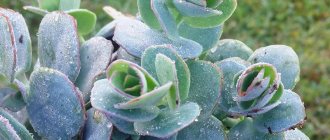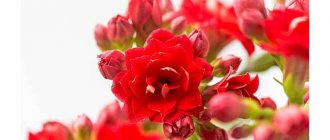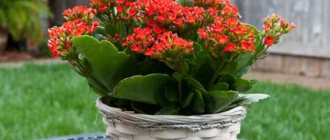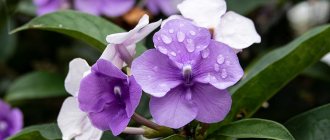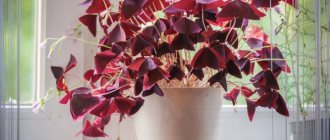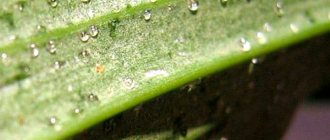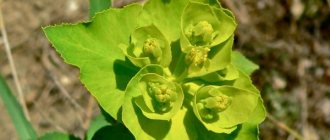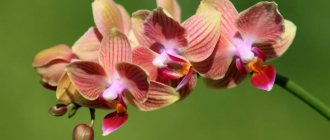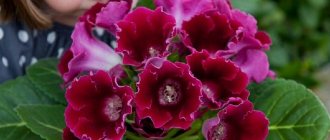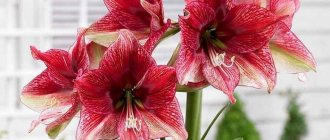Caring for and propagating Kalanchoe at home is quite simple. Kalanchoe is a perennial plant of the Crassulaceae family. In total, there are more than two hundred species in the genus. The places where the flower lives are Australia, Asia and America.
How to grow homemade ginseng - Kalanchoe Degremona plant - in the house? Varieties of Kalanchoe are found in nature. And of course, we pay attention to Kalanchoe with flowers when we are in flower shops. But at the same time, we don’t pay any attention to the unattractive, modest plant. This plant is called Kalanchoe Degremona.
Many diseases can be cured with the help of this plant. If you are concerned about diseases of the internal organs, then it is best to take various decoctions and infusions. If you have a cold or a runny nose, try putting a few drops of Kalanchoe juice into your nose. This plant also has wide possibilities for use. Ointments for external use are also prepared from Kalanchoe.
Reproduction of Kalanchoe by “children”
Along the edges of Kalanchoe leaves there are small shoots - the so-called “babies”. You need to take tweezers and carefully remove the shoots. And when fully ripe, the “babies” fall off on their own.
Next you need to prepare a plastic container. Fill it with soil and water it with water. Then, using tweezers, carefully lay out the “babies” on the surface of the soil. Do not bury, but lightly press down. The distance between the seeds should be approximately 3 cm. Watering should only be done with a spray bottle. It is enough to wet the soil to a depth of 0.5 cm. Then close the container with glass. After two days, lightly moisten the soil with a spray bottle again. Water every other day until the first shoots appear.
What to look for when buying Kalanchoe
If you are going to immediately use the plant for medicinal purposes, you need to take it from friends or your grandmother at the nearest market, and not in a store. There, Kalanchoe is definitely stuffed with fertilizers or stimulants, which will not bring anything good to a person.
When purchasing decorative species, you need to pay attention to the following:
- The leaves should not have spots, spots, rot, or any other damage. Not often, but even reputable stores can receive a batch of plants infected with pests or diseases. No one will throw them away - this is a complete loss. Most likely, the flowers will be treated with a heavy dose of pesticides. But traces will remain, and, possibly, spores or larvae “hidden” in the leaf axils, substrate. Not only will gardeners bring an infected plant into the house, but it will also be weakened by a double or triple dose of the chemical.
- The leaves are elastic, uniform in color. The exception is variegated varieties. There should be no bald spots on the pubescent plates of Kalanchoe Becharian or Felt.
- A good sign is a point of growth in development.
- It is better to refuse the purchase if the Kalanchoe pot is too big. The crop is always sold in cramped shipping containers. The question arises: why was the Kalanchoe replanted?
- Experienced flower growers rarely buy a new plant (except for a very coveted one) unless they allow you to take the bush out of the pot and examine the roots. They should be white or dark straw-colored; a small number of dried shoots are allowed, but not rotten ones. The soil for Kalanchoe smells fresh, but should not stink - this is a clear sign of damage to the root system. Most likely, even if you immediately replant a plant from foul-smelling soil, it will not survive.
- The crop can easily be made to produce buds at any time, so you can buy flowering Kalanchoe not only in winter. It is better if the corollas are closed - by their color it is easy to see what the blossoming buds will be like. This way, at the peak of its decorative potential, the plant will last as long as possible. Bushes in full bloom look better, but will soon wither, especially since they will be exposed to stress from changing conditions.
Advice for transporting purchased Kalanchoe home in winter or late autumn:
- Ask the seller to wrap the entire flower in paper, for example, newspaper purchased in a nearby department.
- Place the Kalanchoe in a large bag.
- Inflate him.
- Tie so that no air escapes.
- Upon arrival home, first remove the bag, and after half an hour - the newspaper. All this time the flower should stand in the hallway.
- The next day it should not be transplanted, but quarantined.
The danger of purchasing Kalanchoe from hand is that it will be a cutting with poorly developed roots.
Care and propagation of Kalanchoe by cuttings
The cutting is prepared by cutting the flower in the middle (see photo). Then we cut off the lower leaves. After the place where the cutting is cut has dried, it needs to be treated with root. Then take a pot with pre-prepared soil and plant the cutting in the hole. Rooting occurs within 8-12 days. Don't forget to moisten the soil with a spray bottle.
Trimming
Flowering Kalanchoe species definitely need pruning. All old and unhealthy-looking parts of the plant should be cut off. The peduncle is also removed at the root at the end of flowering. It is worth keeping in mind that flowering weakens growth.
To prevent the flower from stretching upward and acquiring side shoots, the tops are pinched in the summer.
How to grow Kalanchoe
The plant needs to be watered every day in summer, provided the pot is large. Plants in small pots need to be watered every other day. It would be enough. It is advisable to water as the soil dries. In winter, Kalanchoe should be watered no more than once a week. This plant is a succulent, so it can live without moisture for a long time.
Growing conditions
After planting the plant, it needs to be provided with the correct growing conditions. You need to act in accordance with the following algorithm:
- Place the pot with the plant on the sunny side. The flower loves bright sunlight. In spring and summer, it is advisable to grow Kalanchoe on western or eastern windowsills. The plant really needs light; without it, Kalanchoe may begin to fade.
- From the end of November to the beginning of March, the plant should be placed on a south-facing windowsill. Please keep in mind that flowering is possible only when daylight hours decrease. If you want the flowers to appear not in winter, then you need to put the plant in a dark place in the evening and return it to the light in the morning. This will trigger the appearance of flower stalks.
- When growing a flower outside the home, such as outdoors or in a greenhouse, place the pot in a slightly shaded area.
- The plant must be in warm conditions. The ideal temperature is +13… +30 degrees. But at the same time, Kalanchoe normally tolerates temperatures of +10 degrees and can even bloom.
- Water the plant regularly, but only after the soil has dried, and during wintering, one watering every ten days is sufficient. You need to pour enough water so that it flows to the bottom of the pot, and then into a tray or saucer (you just need to pour out the excess liquid). This is done because Kalanchoe does not like excess moisture. By the way, if there is humid air in the room where the flower grows, this will provoke diseases. The drier the air, the better for your green pet.
- After the flowering process is completed (usually mid-spring), which lasts about three months, you need to trim the plant so that its height is no more than eight centimeters. For pruning, you can use ordinary garden shears, which should preferably be disinfected.
- After pruning, the pot with the plant must be moved to a shaded place, excluding the possibility of direct sunlight. Do not water the flower for 25-30 days after pruning.
- After the specified time has passed, you can return the pot with the plant to the light. Water the flower.
- Do not forget to fertilize the plant in a timely manner. The best option for this is a special fertilizer designed for indoor plants. It must be used in accordance with the instructions, fertilizing the flower after watering. It is enough to fertilize once a month, starting from March and ending in November. During flowering, the plant is not fertilized.
- Once a season (with the exception of winter, when the plant blooms), you need to inspect the Kalanchoe for the presence of dead leaves. And also periodically wipe the vegetative mass with a damp cloth to get rid of dust. But keep in mind that spraying the plant with water is highly not recommended.
It is allowed to grow the flower not only at home, but also outdoors (preferably indoors) in areas where there are no severe frosts during winter (the southern part of the country).
Top dressing
Kalanchoe is not picky. If you need to grow a large amount of material for treatment, then you can feed it with nitroammophoska.
Kalanchoe loves light, but is not afraid of the sun either. Therefore, you can safely place the flower on the windowsill on the sunny side.
Transfer
Kalanchoe still loves a cramped pot. The plant does not take root well in large pots. Therefore, the flower needs to be replanted as the roots grow.
Temperature
Kalanchoe is native to the desert, so this plant is very heat-loving. And the temperature regime must be maintained in accordance with the hot climate. The optimal temperature for Kalanchoe is from +20 to +28 degrees. At temperatures below +10, the Kalanchoe flower begins to freeze. At zero temperature, or at -1 degrees, the plant freezes.
Proper care and cultivation of Kalanchoe will delight gardeners with good growth. Homemade ginseng will help get rid of many diseases and bring many benefits.
How to plant at home?
Kalanchoe flowers are large and beautiful , they can become a worthy interior decoration, and also be beneficial in the treatment of certain diseases in humans and animals. They come in white, pink and red.
The stem is thick, as are the leaves.
The plant does not require special care and belongs to the succulent family. It must be replanted periodically, as this improves nutrition, increases the amount of air supplied to the roots and, if painful processes have started, saves the plant from death. Planting Kalanchoe at home should be done in the following order :
- Prepare the pot.
- The plant, if you take it out of an old pot, must be watered beforehand.
- Tilt the pot on its side and tap on its sides, and then quickly pull the pot off and free the roots of the flower.
- If there is rot or any painful areas around the root system, trim it back carefully.
- Place the plant in the pot. The root collar should be at the same level as the soil. The edge of the pot should be 2-3 cm above it.
- Additionally, sprinkle everything with soil, compact it and fill it with water.
- At the last stage, you should sprinkle everything with a small layer of pebbles.
If you want to plant a Kalanchoe shoot, then use the following instructions:
- Place the cutting in water and wait for the roots to appear.
- Plant it in the same way as a purchased plant.
- Water thoroughly.
- Cover the shoot with a glass jar to speed up the development of the shoot to the size of an adult plant.
Pot selection
It is better to choose a pot in which you are going to grow it with a deep and wide diameter.
The material for production must be natural so that the plant can breathe . Place a drainage layer consisting of expanded clay and clay at the bottom. Moreover, the materials of this layer should not be toxic. The height of the drainage layer should be approximately one-fourth of the height of the pot.
Soil selection and preparation
Before planting a plant, you need to choose the right soil. When purchasing, consult the seller about what kind of soil you need to choose. However, it is worth remembering some features of this plant.
Important! Kalanchoe does not develop well in an acidic environment and may even die, so add a little lime to the soil mixture.
If you don't want to bother, just buy a ready-made soil mixture for succulents . If possible, make the mixture yourself: mix humus, coarse sand and soil in equal proportions.
Reproduction and planting
There are many methods suitable for propagating Kalanchoe. The most popular include the following.
Plant with foliage
One of the easiest ways to propagate Kalanchoe is using leaves.
Moisten the soil and cut off a Kalanchoe leaf, then place it in the ground. To ensure high humidity, you need to cover the plant with a glass cap . Within a few days, the leaf will begin to strengthen and will be ready for a full transplant.
Video about the propagation of Kalanchoe by foliage:
Cutting off doom
This type is similar to the previous one, but remember that already dried leaves are not suitable. Take a fallen leaf, place it in a glass of water and wait until small roots appear on the leaf. Then repeat the same steps as with a regular separated leaf. If you see drying leaves, then cut them yourself and repeat the propagation process as for a fresh leaf.
Plant a cutting
Cuttings are small shoots produced by a plant. Their length should be approximately 12 cm. Use shoots from the top, as they are more developed. There are 2 ways to reproduce them:
- Soil . Wither the cutting for 24 hours. Remove various leaf blades from the bottom of the shoot, then place the shoot in a hole, the depth of which should be at least 5 cm. Pre-moisten the soil. Wait 3 weeks for rooting.
- In water the process occurs in exactly the same way as for soil. However, when you put the cuttings in water, do not let there be too much water. Do not place the cutting in water on a windowsill: sunlight can harm the shoot. After 3 weeks, plant the cuttings in the ground.
Video about planting Kalanchoe cuttings:
Propagation by seeds
Using seeds, you can grow those types of Kalanchoe that are considered rare and are not found on sale as often as traditional types of this plant. First, prepare the soil, which should be peat-sand. Then the seeds are scattered on the surface of the earth, after which everything is covered with glass.
The right approach
Before starting a Kalanchoe, decide on its purpose. If you want to use it as a medicine for a cough or runny nose, then you should pay attention to a variety such as bryophyllum. Recently, this species has been classified somewhat differently, separating it from other representatives of the Tolstyankov family into a separate genus. Therefore, in this material we will not focus on it, but will talk only about flowering Kalanchoe.
How to grow this flower? In this article we will look at such facets as:
If you want to decorate a house or apartment, then pay attention to the lushly blooming Kalanchoe. Choose colors that will go well with the interior of your rooms. If you are interested in the healing properties of this plant, then choose Kalanchoe with wide, thick leaves. Not everyone knows that if you tape a sheet to a fresh burn, then after a short period of time there will be no trace of redness left. Of course, we are talking about cases where the burn is not serious.
Choosing a pot for Kalanchoe
This plant has a very interesting root system structure. It is quite sensitive, so the container for transplantation must be chosen carefully
Let's take a closer look at what selection criteria exist and what you need to pay attention to.
Growing rules and choosing a flowerpot
When buying a new pot, you should know the basic rules for planting and caring for Kalanchoe, and the features of its life cycle.
- The plant tolerates changes in day and night temperatures very well and needs sunlight.
- Kalanchoe needs to be watered regularly, but in small portions, since the roots begin to suffer if the plant is flooded and the soil becomes waterlogged. Root shoots can turn sour, which leads to plant disease and sometimes even death.
- Also, the roots need the required amount of oxygen, so it is advisable to loosen the soil in the flowerpot regularly, preventing the formation of a crust.
- If the plant is too small, it often begins to hurt after the transplantation procedure. The reason may be the lack of disinfection of the container before planting.
Based on this knowledge, it is necessary to choose the right pot size and material so that the flower develops well, grows and gives a beautiful and lush plant.
Which pot is suitable?
It is not recommended to use a container in which other indoor plants have previously grown. Spores of pathogenic bacteria or viruses may remain on the flowerpot. Therefore, it is better to buy a new pot for Kalanchoe, which needs to be disinfected.
The container must be purchased only a few centimeters larger than the previous one. If the roots are peeking out from the old flowerpot, and they are completely entangled in an earthen ball, then a transplant is already needed. When you plan to transplant Kalanchoe in adulthood, the old pot should fit tightly into the new one. It is this container that is suitable as a “new place of residence.” If the flowerpot is too large, then the Kalanchoe will not bloom until the root system has grown to almost its entire volume. All this time, only leaves and stems will actively grow. When there is too much room for roots, excess moisture will lead to acidification of the soil. As a result, the plant will be susceptible to disease. You should not buy a plastic flowerpot, but the most successful option would be a clay or ceramic one, but glazed, smooth and at the same time porous
It is this kind of pot that allows oxygen and moisture to pass through well, which is very important for the normal development of the Kalanchoe bush. You should not buy a product that is too expensive, since for this plant it is important that the sides become enveloped in peat over time, and salts will also be deposited from the water accumulating in the pan. Be sure to make sure that there are no deep cracks, chipped edges or scratches on the inner surfaces of the flowerpot. Over time, various fungal spores or pathogenic bacteria can accumulate in them.
Modeling
Fans of large, massive leaves should resort to a little trick on how to grow lush Kalanchoe. What is it? In correct pruning of the plant. If a person wants it to look like a tree, then only the tops of the Kalanchoe need to be picked. Then young shoots will come from these places, and as a result your plant will have a lush crown. When the owner wants to give the plant a bushy shape, it is necessary to dive as close as possible to the base of the Kalanchoe. This pruning will help give the flower a lush, bushy appearance.
Reproduction by offspring: how can this be done?
Before you begin propagation in this way, you need to select a plant. It must be mature and healthy. After the selected Kalanchoe has faded, you need to pinch the tops of its stems. After this, young offspring appear near the mother flower. They will be used for replanting. This will happen after they grow to a third of the height of the mother flower. They are carefully separated, trying to keep the roots intact. The offspring are immediately planted in separate pots, filled with peat-sand substrate.
This option is very convenient because young plants take root quickly and grow quickly.
It is better to take not very old branches for propagation
Emergency Kalanchoe transplant after purchase
A plant purchased during the flowering period should not be disturbed. It is best to transplant it into a new container after all the buds have faded and begin to dry out. Then the flower stalks are removed and the crown is formed by shortening some of the shoots.
But there are critical situations when replanting a flowering Kalanchoe is necessary for some reason. Then you should not wait for a certain stage of flower development recommended to change the soil substrate and pot. Here you have to choose not flowering, but the health of the plant.
An emergency transplant occurs in the following cases:
- The plant was affected by root rot. At the very beginning of the disease, there is a chance that the flower will be saved and will continue to develop safely. The roots freed from the ground are examined and the sick ones are cut off. The entire root is treated with a solution of potassium permanganate or any antifungal agent and allowed to dry for a couple of hours. Then the flower is transplanted into a new container. At first, monitor its standing and water it very sparingly.
- Replanting is also required when insect pests appear in the soil. Simple treatment of the above-ground parts of plants may not bring results. Therefore, the new flower is removed from the soil, and the roots are rinsed in a soap solution. If there are diseased roots, they are removed. After treating the underground part of the plant with any fungicide, it is rooted in a new soil mixture.
- Another reason for urgent replanting is poor-quality, moldy soil in the shipping container in which the plant was sold in the store.
But if you have a strong desire to change the plant’s container immediately after purchase, you should use a gentle method of replanting - transshipment. This is the safest option, the roots of the flower are not injured, and the plant itself does not experience any stress. When transferring, you need to remove the entire earthen lump from the pot, carefully move it into a new one, and fill the voids with fresh soil.
Leaves or cuttings: which is more convenient?
Usually, novice gardeners, for fear of making any serious mistakes, try to choose the simplest propagation option. The information in the table will help you choose the appropriate Kalanchoe propagation option.
| Cuttings | Leaves | |
| Desirable breeding time | Spring Summer | All year round, but the most favorable period is May-June |
| Complexity of the procedure | Medium-light | Lightweight |
| Feature of the material | We need strong, beautiful young branches | Any leaves will do, including fallen leaves. |
| Rooting duration | 2-3 weeks | 3-4 weeks |
| Time before flowering | After rooting, the planted plants bloom within six months | It can take about a year from planting a leaf to the appearance of flowers on an already mature plant. |
Basic principles of all methods of reproduction
There are several rules, the observance of which will help the plant to take root well and further develop after any method of propagation:
- It is impossible to pre-soak Kalanchoe elements prepared for transplantation - this guarantees rotting of the part that was lowered into water.
- For planting, you can use either specialized or universal soil.
- You need to water very little so that only the top of the soil remains moist.
- When watering, make sure that moisture does not fall on the young plant.
- If a leaf/shoot withers, this does not mean that it is lost. It is quite possible that it is gaining strength and will soon recover again.
- Sometimes, when planting cuttings, the lower leaves fall off - this is simply the plant getting rid of unnecessary burden.
Planned Kalanchoe transplant
After adaptation, it's time to replant the Kalanchoe. Only if it is not a flowering specimen or flowering has already ended. For replanting, you can purchase ready-made soil mixture. They are sold in stores and are labeled “for cacti and succulents.” Some people prefer to prepare the nutrient soil themselves. For it you will have to take humus, peat, sand and leaf soil in equal parts.
Stages of transplanting Kalanchoe after purchase and adaptation:
- Let's prepare a new pot. It should be the same size as the transport one or a little larger. Rinse the new container with soapy water. If flowers were already growing in the pot, it should be washed and treated with a weak solution of copper sulfate.
- Before planting, steam the soil mixture in the oven. This will help destroy pathogens of fungal infections and insect larvae.
- We place drainage at the bottom of the container. You can add a layer of small pebbles, expanded clay, and small pieces of broken brick.
- Add some purchased or prepared soil mixture.
- We remove the pre-watered plant from the old pot and check the roots. If necessary, treat them with a solution of potassium permanganate. Shake off or wash off the old soil.
- We plant the Kalanchoe in a new pot and carefully add soil. Lightly tamp it down on top to secure the plant.
Subsequent transplants are carried out annually after the flowering period ends.
Kalanchoe blooming: leaves fall, what to do
If the transplant was successful, then after a short amount of time the plant will become green, lush and flower. But sometimes, a year after healthy and abundant growth, many are faced with the problem of fallen leaves and do not know how to deal with it. In most of these cases, Kalanchoe does not look like a well-formed bush, but a tall growing stem with branches, with obvious signs of falling leaves in the area of the root system. There is only one way out: rejuvenate the plant by cuttings.
Peduncles are not a reason to put off cuttings for a plant: the shoots take root wonderfully in an aquatic environment, even with flowers. To give the plant a lush shape and to stop the leaf blade from falling off, cut off the apical part of the flower. You don’t need to immerse it in water for a couple of days for roots to appear, but immediately plant it in the ground. Manipulating the cut top will help combat leaf loss and give the plant a new, healthy appearance. The top can be grown separately, like a new full-fledged flower, by transplanting it into a separate pot.
This video provides material on the proper care of flowering Kalanchoe.
Kalanchoe blooming: replanting, spraying, feeding
You can prepare the soil mixture for replanting yourself, or you can purchase a ready-made one, adhering to the required composition: peat mixture, turf and sand. If you mix the components yourself, then you need to take 4 parts of the total volume of peat base, 2 parts of turf substrate and 1 part of ordinary sand. 1 kg of the mixture should contain 15 grams of special superphosphate.
Drainage is always poured into the bottom of the pot, followed by prepared soil. The last layer is carefully compacted and a mound is formed in the central part of the top layer, where the cut top of the Kalanchoe is placed. Immediately after transplanting, it is necessary to water the root system as abundantly as possible so that the water reaches the drainage layer. When the soil dries out, intensive watering should be stopped.
Lighting also plays a big role in the process of caring for a domesticated representative of the tropics. The temperature regime should not be disturbed: the optimal temperature for quality care should be 18 - 28 degrees during the warm season, and 14 - 20 degrees during the cold season. If the readings drop below 10 degrees, the plant may die or become stressed. During the watering process, it is necessary to monitor the soil and water it when it is already dry. Even on hot days, it is enough to water Kalanchoe only a couple of times during the week, because... Excessive moisture harms the plant’s bark system.
Spraying the flower is not a prerequisite during the care process, but it can be used as a preventative measure (just not in extreme heat) and avoid treating plants with pubescent leaves. It is recommended to apply fertilizing during the period of bud formation; you can do this during the flowering process. Compositions for succulents are suitable as fertilizers; mixtures for cacti can also be chosen. They are applied in a half dose once for seven days. You should not fertilize Kalanchoe in the cold season, only in cases where it is in dire need of minerals. The first half of spring or summer is ideal for the feeding period.
In this video you can learn how to form a beautiful shape for a Kalanchoe. Don’t forget to leave your questions about the article in the discussion.
Acceleration of flowering
Next, let's look at some tricks that will help you understand how to grow flowering Kalanchoe. People often complain that their plant has no or very few flowers. The fact is that there are at least two important points regarding how to grow a Kalanchoe flower not just lush, but also with abundant flowering.
One of them is the deliberate shortening of daylight hours. The plant should be in the sun no more than ten hours a day. The rest of the time it should be shaded. For this purpose, some people hide the plant in a closet at night or take it to a dark room. But this is not very convenient, and transportation itself causes unnecessary stress to the plant. What to do in this case?
The ideal option is to pick up a cardboard box or bucket and cover the Kalanchoe with it overnight. This procedure must be done for a month, without skipping days. Many people are outraged that this is too troublesome and are looking for other, easier ways, for example, closing the shutters. But this is not entirely effective, since even electric lighting brings the plant out of dormancy. Therefore, it is better to be patient and put the makeshift cap on the plant in the evening and remove it in the morning. When it throws out sockets, you can stop shading it.
The second thing that helps speed up flowering is trimming a few large leaves. This procedure gives the plant a boost in development. But it's important not to overdo it. It is enough to cut one or two leaves. Such a little stress will not harm the plant, but will only invigorate it a little.
Important nuances
The procedure itself is as follows: you need to take a rosette of flowers in your hands and go down the stem. Then you should cut off the last one with scissors, just below the second axil of the leaves. After you have cut all the stems with flowers, select the largest leaves and remove them. Only 5-10 leaves need to be left for the photosynthesis process to take place.
The plant treated in this way should be placed in partial shade and occasionally watered with settled water, avoiding excess moisture. After some time, young shoots will appear in place of the cut leaves. When dense roots form at the base of these shoots, you can begin the propagation procedure.
To do this, simply trim the shoots just below the roots, about a centimeter. Then remove two leaves near the roots and start planting.
Botanical description of Kalanchoe
Kalanchoe is a typical representative of the succulent genus. This is proven by the juicy, fleshy leaves and stems, the tissues of which are capable of storing water. It is not without reason that in places where Kalanchoe grows, its succulent shoots are used to quench thirst. The juice of the plant is quite pleasant with a sour taste. It also has medicinal properties.
Kalanchoe is native to the warm countries of Asia, South America and Africa. The flower grows in both tropical and arid regions, and is also found on mountain slopes. In the wild, this succulent reaches a height of two meters. More compact species are grown at home. Among them there are different varieties. For example, in the form of an upright bush with inconspicuous buds. There is also a flowering Kalanchoe, which blooms many bright inflorescences during the winter season. Unlike many of its domestic counterparts, this plant prefers short daylight hours for flowering. And when there are Christmas frosts outside the window, Kalanchoe mix inflorescences light up on the windowsills with bright lights.
General brief characteristics of the plant:
- The root system is fibrous.
- The leaves are sessile or petiolate of different shapes and thicknesses, depending on the specific variety.
- The inflorescences are paniculate, resembling small umbrellas in appearance, and contain many flowers.
- The flowers are simple and double, erect and drooping in different shades: from white and pink to bright red and purple.
Kalanchoe is grown for decorative purposes. There are several species whose leaves have medicinal properties. This is Kalanchoe Degremona and pinnate.
Main characteristics of the succulent plant
The roots of Kalanchoe are thickened and fibrous. The stem of the plant is fleshy, sometimes lignified, covered with succulent thick leaves arranged in an opposite spiral. The type of leaf plates depends on the variety and can be:
- Edged.
- Feathery.
- Simple.
- Have a jagged edge.
In the same way, the sizes of the leaves can be different, so you can see a flower of this species with large leaves, like burdock, or, conversely, with small leaves. Peduncles are located either at the top or on the stems next to it. The flowers have four petals, which can be bright red, pink, white, orange or purple.
How to grow Kalanchoe from a shoot that does not have a root system?
In any case, such a plant needs to go through the rooting stage. There are two ways to develop the root system:
Many people immerse the shoot in water and wait for roots to form. Then the plant is carefully transplanted into the ground and cared for. Since Kalanchoe is a very tenacious and unpretentious plant, this method has a right to exist. Even if young roots are damaged when planting in the ground, the plant will sprout new ones. Of course, this will slow down the development process and the beginning of flowering of Kalanchoe.
Other flower lovers root the shoot directly into the ground.
For this purpose, they pour soil into a large plastic cup and moisten it well, then immerse the shoot, compact the soil and place the plant in a ziplock bag. It turns out to be a mini-greenhouse in which the shoot is kept for about 20 days. Since the glass is transparent, you can observe the development of the root system. At this time, the shoot not only gives roots, but also sends out new shoots.
When the rooting stage ends, the plant can be transplanted into a cache-pot or pot. Since the transshipment is carried out together with a lump of earth, such a flower does not get sick and grows quickly. For this reason, this method has gained wide popularity among experienced gardeners.
Types of Kalanchoe with photos
The genus has about 20 species. Many types of Kalanchoe are grown at home.
Kalanchoe blossfeldiana
This species is famous for its numerous flowers collected in an umbrella inflorescence. The flowers are located on long stalks and come in a variety of colors. The plant is very unpretentious to care for.
Kalanchoe manginii
Ampelous look. The flower is miniature (up to 15 cm) and is distinguished by exotic inflorescences resembling small bells. Flowering usually occurs in spring.
Kalanchoe daigremontiana
This species blooms quite rarely exclusively in winter. The height of the plant reaches 50 cm. It has a straight stem and long (up to 10 cm) green triangular leaves. The leaves are covered with many purple spots.
Kalanchoe pinnata
It is considered the hardiest species. It is distinguished by its height, reaching 1 m. The color of the flowers is unusual: white tones, smoothly turning into green. The juice of this type of Kalanchoe is sold in pharmacies.
Kalanchoe bentii
The species is represented by subshrubs reaching a height of 1 m. Platinum leaves are up to 50 cm long, quite thick and weighty. White flowers are collected in umbrella inflorescences. Flowering occurs in mid to late spring. Tolerates cultivation well in cool rooms.
The species is represented mainly by shrubs. The leaves are serrated and covered with small hairs.
Kalanchoe tomentosa
Representatives of this species are subshrubs. The stem is erect, the leaves have small hairs. Miniature flowers are collected in umbrella inflorescences.
Kalanchoe grandiflora
The species is also known as Kalanchoe marmorata. These are mainly subshrubs reaching a height of 50 cm. The leaf blades are green. In direct sunlight, the leaves may turn pale red. The yellow flowers are collected in an umbrella inflorescence and have a pleasant aroma. Flowering begins in late spring.
Kalanchoe thyrsiflora
Plants of this species reach a height of 50-60 cm. At the base, the leaves are arranged densely; closer to the top, the leaves become smaller and sparser. The flowers are yellow in color. Flowering occurs in late spring.
Kalanchoe flammea
The species is known as Kalanchoe glaucescens. The height of the plants reaches 40 cm. The leaf blades become wider and larger closer to the top of the plant. The leaves are round and green with white edges. Orange flowers are collected in umbrella inflorescences.
Kalanchoe tubiflora
The species is represented by subshrubs reaching a height of 70 cm. The leaf plates are gray-green in color and have a narrow, elongated shape. The leaves of the plant are covered with brown spots.
Kalanchoe dissected (Kalanchoe laciniata)
The species is also known as Kalanchoe lobata. The stems of the plant eventually sink down under their own weight, shedding leaves at the base. The green leaves have a dissected shape. The flowers are yellow or orange.
Kalanchoe Kalandiva
The species was obtained through selection. It is distinguished by its modest size and six-month flowering period.
The Kalanchoe plant is easy to care for at home, even beginners can do it. If you follow certain rules, the flower will constantly delight you with its appearance and beauty.
Breeding
First, let's talk about the most proven method, which is often used in greenhouses and flower beds. This method guarantees a healthy, lushly flowering plant. What is its essence? The most important thing is to find a good shoot with roots. Where can I get it? It is best to ask or buy such a sprout from those who have been propagating flowering Kalanchoe for a long time. Professionals in this field usually have several plants for just such purposes.
If you do not have the opportunity to find such a shoot, you will have to be patient and start reproducing yourself. You will need a Kalanchoe in the flowering stage and scissors. The optimal time of year for such a procedure is June-August. It is important that the weather is hot and dry.
